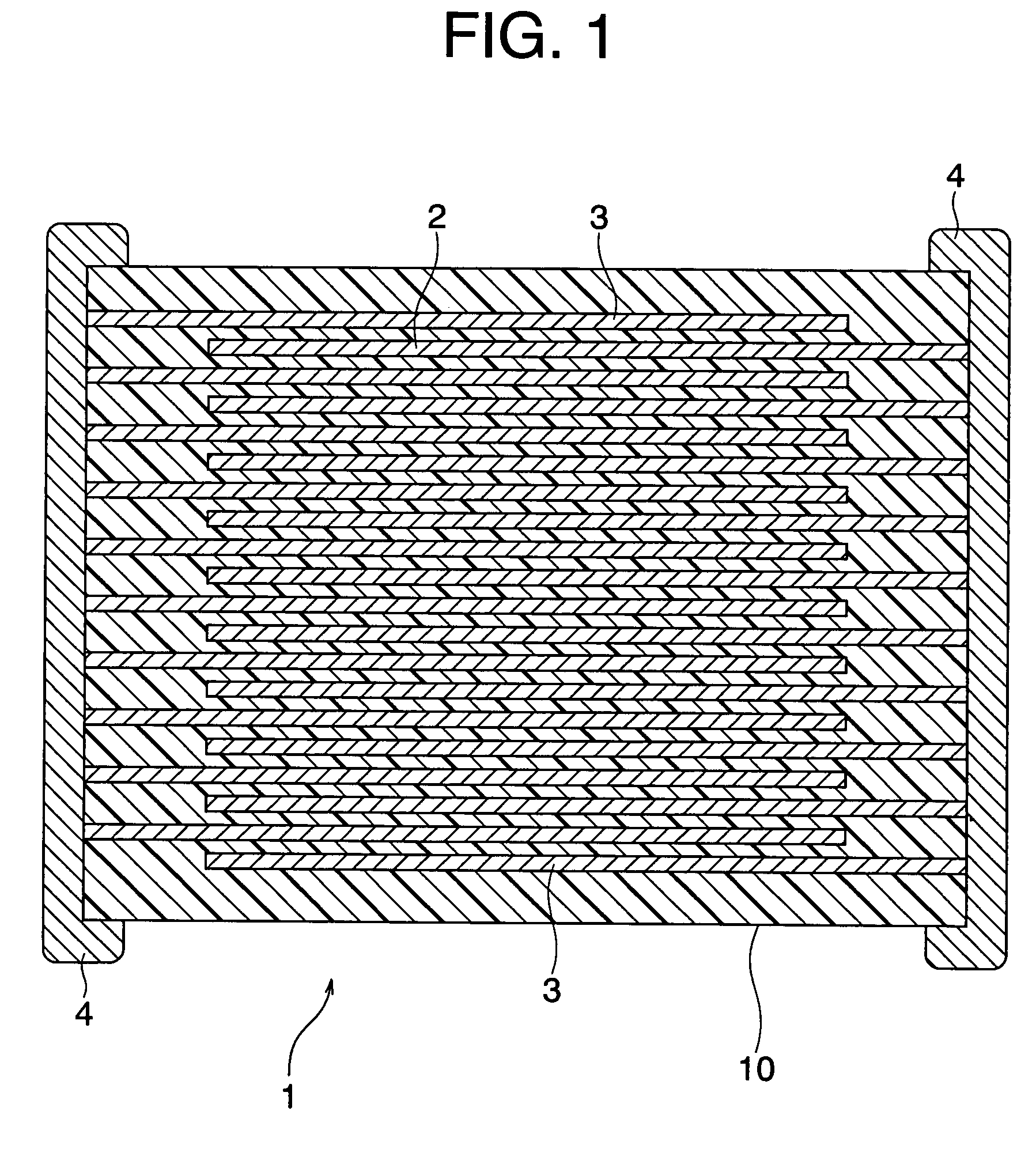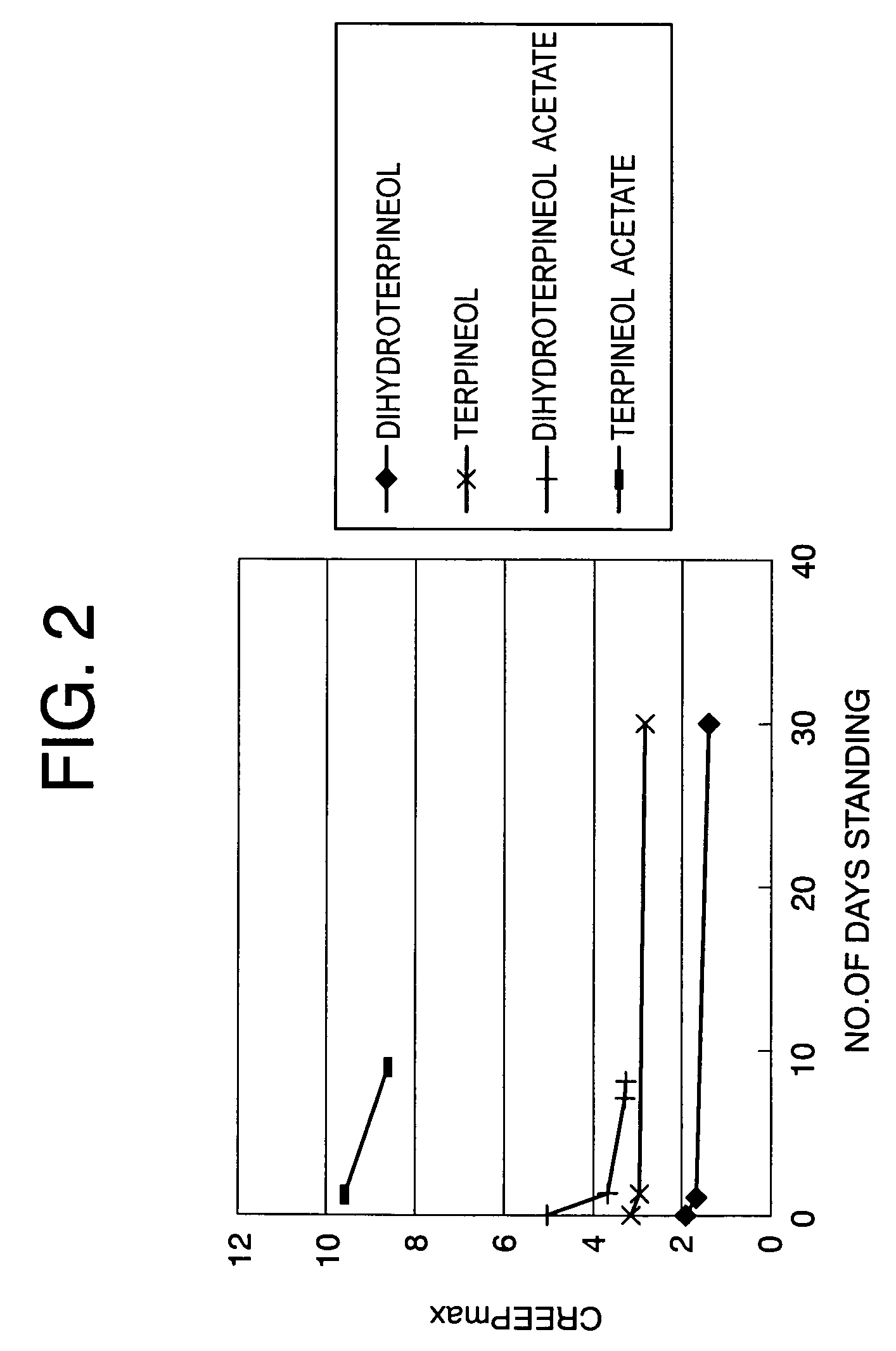Conductive paste and multilayer ceramic electronic device and its method of production
a multi-layer ceramic and electronic device technology, applied in the direction of resistive material coating, non-conductive material with dispersed conductive material, fixed capacitors, etc., can solve the problem of ceramic green sheet becoming hard to peel off, ceramic green sheet not becoming a practical problem, and accurately reducing the electrode pattern to a predetermined thickness cannot be obtained, etc. problem, to achieve the effect of easy adsorption of conductive powder, good rheology and low viscosity
- Summary
- Abstract
- Description
- Claims
- Application Information
AI Technical Summary
Benefits of technology
Problems solved by technology
Method used
Image
Examples
embodiment
Actions and Effects of Embodiment
[0081]In the present embodiment, terpineol acetate is used as the solvent of the conductive paste. Therefore, there is less change in viscosity of the conductive paste along with time and the change in thickness along with time at the time of electrode formation can be suppressed.
[0082]Further, in this embodiment, the terpineol acetate used for the solvent of the conductive paste does not cause the polyvinyl butyral contained as an organic binder in the ceramic green sheet to swell or dissolve. That is, it does not cause sheet attack, so even if the thickness of the ceramic green sheets is for example a thin 5 μm or less, when printing the conductive paste, then peeling off the ceramic green sheets from the carrier sheets, the peelability of the ceramic green sheets is improved and the ceramic green sheets wrinkling, being punctured, cracking, etc. can be effectively suppressed. That is, even if the ceramic green sheets are made thinner than ever bef...
example 1
Preparation of Organic Vehicle
[0087]The ethyl cellulose used as the organic binder and the solvent shown in Table 1 were prepared.
[0088]Next, 10 parts by weight of the organic binder was made to dissolve in 100 parts by weight of the solvent to prepare an organic vehicle.
[0089]Evaluation of Creep Characteristic and Tan δ
[0090]The “creep characteristic” and “tan δ” of the obtained organic vehicle were evaluated by observing their fluctuation.
[0091]For the “creep characteristic (creep measurement)”, the fluctuation in the maximum creep value when applying a stress of 1 Pa to the obtained organic vehicle was measured by a viscosity / viscoelasticity measurement system (Rheostress RS1, made by Eiko Seiki). The results are shown in FIG. 2. The larger the value of the maximum creep (displacement) with respect to the number of days of standing, the better the creep characteristic, that is, the better the leveling ability, and the higher the solubility (the better the dissolution), it is beli...
example 2
Preparation of Dielectric Paste
[0100]A BaTiO3-based ceramic powder, polyvinyl butyral (PVB) for use as an organic binder, and methanol for use as a solvent were prepared. Next, with respect to the ceramic powder, 10 wt % of an organic binder and 150 wt % of a solvent were weighed and kneaded by a ball mill to form a slurry and obtain a dielectric paste.
[0101]Preparation of Test Samples
[0102]PET films were coated with the above dielectric paste by the doctor blade method to a predetermined thickness and dried to form ceramic green sheets with a thickness of 1 μm. Next, the obtained ceramic green sheets were formed with conductive paste containing the terpineol acetate used in Example 1 by the screen printing method in predetermined patterns to obtain ceramic green sheets with electrode patterns of a thickness about 1.0 μm (test samples).
[0103]Evaluation of Test Samples
[0104]The obtained test samples were used to evaluate the “presence of sheet attack” and the “peelability of the PET ...
PUM
| Property | Measurement | Unit |
|---|---|---|
| thickness | aaaaa | aaaaa |
| thicknesses | aaaaa | aaaaa |
| thickness | aaaaa | aaaaa |
Abstract
Description
Claims
Application Information
 Login to View More
Login to View More - R&D
- Intellectual Property
- Life Sciences
- Materials
- Tech Scout
- Unparalleled Data Quality
- Higher Quality Content
- 60% Fewer Hallucinations
Browse by: Latest US Patents, China's latest patents, Technical Efficacy Thesaurus, Application Domain, Technology Topic, Popular Technical Reports.
© 2025 PatSnap. All rights reserved.Legal|Privacy policy|Modern Slavery Act Transparency Statement|Sitemap|About US| Contact US: help@patsnap.com



